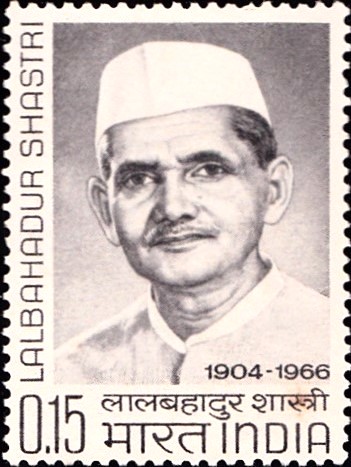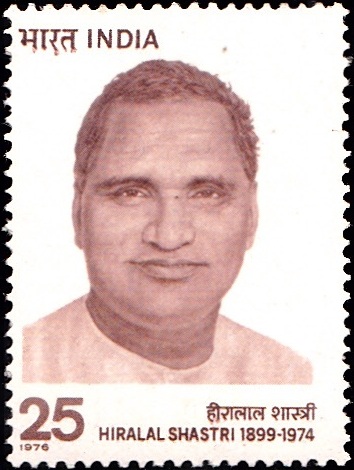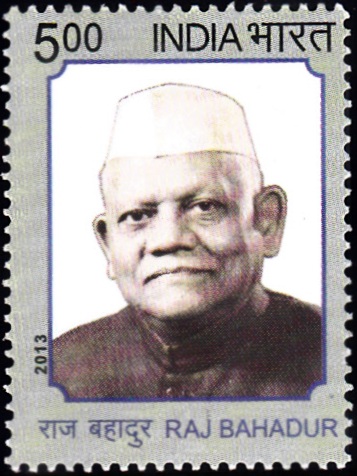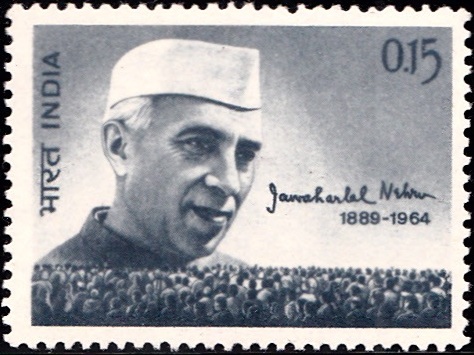
India on Lal Bahadur Shastri
A commemorative postage stamp on 2nd Prime Minister of India (1964-66), Lal Bahadur Shastri mourning issue, after his mysterious death in Soviet Union (now Uzbekistan) after signing the Tashkent Declaration with Pakistan :
 Issued by India
Issued by India
Issued on Jan 26, 1966
Type : Stamp, Mint Condition
Colour : Suede Gray
Denomination : 0.15 naya paisa
Overall Size : 3.91 X 2.90 cms.
Printing Size : 3.63 X 2.62 cms.
Perforation : 13
Watermark : Printed on unwater marked paper
Number Printed : 50,00,000
Number per issue sheet : 35
Printing Process : Photogravure
Designed and Printed at : India Security Press
Name : Lal Bahadur Shastri
Born on Oct 2, 1904 at Varanasi, Uttar Pradesh, India
Died on Jan 11, 1966 at Tashkent, Uzbekistan
About :
- The passing away of Shri Lal Bahadur Shastri at Tashkent within hours of concluding an agreement with Pakistan pledging our two countries to work for peace and friendship, came as a great shock to the people of India and to the whole world. Throughout his career as a politician and a statesman he had devoted much of his efforts to dissipating antagonisms and rivalries. The 19 months during which he was Prime Minister were beset with many difficulties but he brought to them a clam and unruffled judgment. The Gandhian simplicity of his life was matched with a resolution of purpose which difficulties only served to strengthen. His humility was genuine because it had its foundation in spiritual strength. When the time demanded he could take the decision to use force of arms to defend his country’s honour and at the first opportunity work again, with equal courage, for peace.
- We can best preserve his memory by living together in unity and harmony and in friendship with our neighbours.
- – S. Radhakrishnan, Rashtrapati Bhavan, New Delhi-4, January 18, 1966.
- We are still recovering from the shock of Shri Lal Bahadur Shastri‘s sudden passing away. He worked for freedom all his life and died in the cause of peace. Gentle, strong in inner resources and wise, he belongs to the great tradition of Indian leadership. He led India through a time of trial and enabled it to emerge stronger. He upheld and furthered the basic ideals of Mahatma Gandhi and Jawaharlal Nehru.
- The commemorative stamp that the Posts & Telegraphs Department is issuing is a token of the high place Lal Bahadurji will occupy in our hearts and in the history of our land.
- – Indira Gandhi, 1, Safdarjang Road, New Delhi, January 21, 1966
- In issuing a special commemorative stamp in honour of the late Prime Minister Shri Lal Bahadur Shastri, the Posts and Telegraphs Department will pay its humble tribute to a great leader and statesman. The sudden passing away of Shri Lal Bahadur Shastri so soon after the country had lost Pandit Jawaharlal Nehru, is indeed a great national loss. The period of nineteen months during which Shastriji guided the destinies of the nation was short but the country had to pass through extremely difficult times and it fell to his lot to save the sacred soil of India not only from external aggression but to provide a stable basis for peace in this part of the world. His moral strength and cool courage in times of crisis, his humility and his high sense of duty won him universal respect and affection. Basically a man of peace, he spared no efforts to avoid conflicts both in the national and international spheres. Wedded to the principle of peaceful co-existence, with his usual farsight and sagacity, he concluded the memorable pact of peace at Tashkent before he breathed his last. Shastriji‘s name will go down in history as one of the greatest architects of India‘s destiny and his life and deeds will indeed be a source of inspiration to all of us and to prosperity.
- – Satya Narayan Sinha, Minister of Communications and Parliamentary Affairs, New Delhi.
- The Gazette of India
Extraordinary
PART I – Section I.
New Delhi, Thursday, January 13, 1966/Pausa 23, 1887
President’s Secretariat
Notification
New Delhi, the 13th January 1966- No. 2-Pres./66. – The sudden demise at Tashkent of Shri Lal Bahadur Shastri in the early hours of Tuesday, the 11th January, 1966, has plunged the nation into deep distress and grief. Shri Lal Bahadur Shastri went to Tashkent in the cause of peace and it is a great tragedy that just when his persistent efforts towards a settlement for an honourable and enduring peace in this sub-continent achieved fruition, fate delivered a cruel blow and removed him from our midst.
- Born in 1904, at Mughalsarai in Uttar Pradesh, Lal Bahadur Shastri lost his father while he was still an infant. How this infant, born in a modest environment, rose to the higher political office in this country, is an inspiring saga of noble endeavour, unwavering sincerity of purpose, and a high sense of patriotism and integrity in public life.
- Lal Bahadur Shastri was only 17 years old when the call came from Mahatma Gandhi and without hesitation he plunged himself in the freedom struggle. He was soon imprisoned. On release he entered the Kashi Vidyapeeth at Varanasi and came under the influence of the savant, Dr. Bhagwan Das. He took the Shastri degree from the Vidyapeeth and re-entered active politics.
- At the age of 23, Lal Bahadur Shastri was married to Shrimati Lalita Devi, who has always stood by him as a steadfast companion to the very end of his life of sacrifice and devotion to the Nation.
- Lal Bahadur Shastri had participated in all the mass movements launched during India‘s fight for freedom and was imprisoned as many as seven times. In 1946, he was elected to the Uttar Pradesh Legislative Assembly and was appointed Parliamentary Secretary to the Chief Minister. Subsequently, he was appointed Minister of Police and Transport. This portfolio he held for nearly five years.
- In 1952, when the first general elections were held in India after the attainment of independence, Lal Bahadur Shastri was entrusted by the Congress party with the task of organising the election campaign; the great success which the party secured at the polls in these elections was in no small measure due to his organising capacity.
- Lal Bahadur Shastri became a member of the Rajya Sabha in the first session of Parliament. He was appointed Union Minister for Transport and Railways in 1952. Four years later, he resigned his ministership, because he felt he was constitutionally responsible for a railway accident in which many lives had been lost. This was symbolic of his staunch faith in and sincere endeavour to live up to the highest traditions of parliamentary democracy. Expressing his deep appreciation of this step in Parliament, the late Prime Minister Nehru described Lal Bahadur Shastri as a man of the highest integrity with devotion to high ideals.
- The call to assume the responsibility of a high public office came to Lal Bahadur Shastri again in 1957, when he was elected to the Lok Sabha and was assigned the portfolio of Transport and Communications in the Union Cabinet. In March 1958, he became Minister for Commerce and Industry. Later, on the death of Shri Gobind Ballabh Pant, in April 1961, the important portfolio of Home Affairs was entrusted to him.
- As Minister for Home Affairs, Lal Bahadur Shastri brought into play his gifts as an able administrator, and he handled a number of complex and intricate political and administrative problems.








[…] this University is a leading educational institution of the country, whose alumni include erstwhile Prime Minister Lal Bahadur Shastri, Kamalapati Tripathi, Dr. Balkrishna Keskar and many other leaders and freedom fighters. Jawaharlal […]
[…] at Calcutta. This was found to be unwieldly and on 17th June, 1955, the then Railway Minister, Shri Lal Bahadur Shastri announced the separation of old East India Railway and Bengal–Nagpur […]
[…] in the organization as a ward president. He was deeply influenced by Gandhi – Nehru ideology and Sri Lal Bahadur Shastri became his guiding […]
[…] offensive by its regular Army. It was in context of these early developments that the then Prime Minister of India desired a thorough review of security arrangements at the borders against Pakistan be carried out […]
[…] till his last breath and was succeeded by Babu Rajendra Prasad. After that, leaders such as Lal Bahadur Shastri, Smt. Indira Gandhi, Rajiv Gandhi, P.V. Narasimha Rao, R. Venkataraman, Dr. B.D. Jatti, and Justice […]
[…] 1975, the National Academy of Administration was named after the country’s second Prime Minister Lal Bahadur Shastri, an epitome of humility and […]
[…] Basu can best be summed up in the following tribute paid to him by our late Prime Minister, Shri Lal Bahadur Shastri […]
[…] “Jai Jawan, Jai Kisan” was given to the country by our revered leader the late Shri Lal Bahadur Shastri. The Jai Jawan stamp was brought out last year on Republic Day as a tribute to our Armed […]